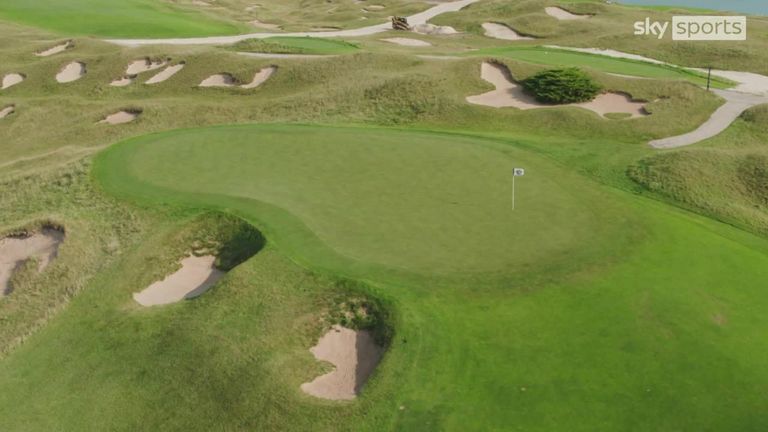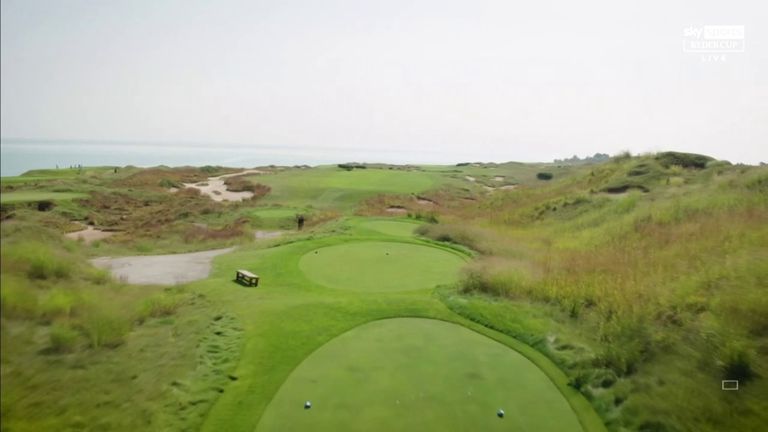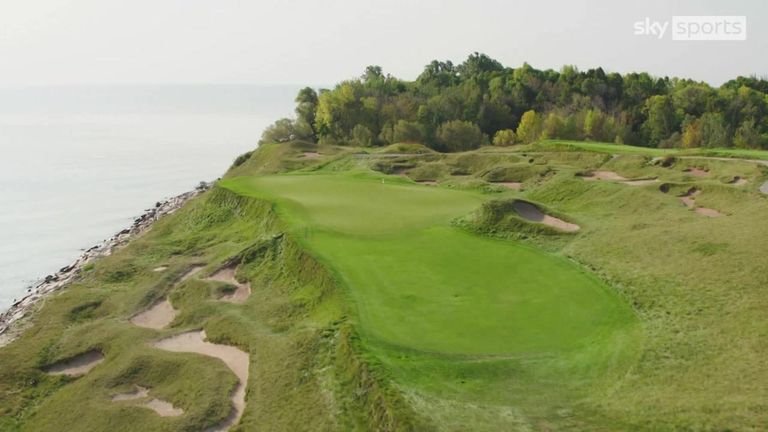Ryder Cup 2020 course guide: Jim 'Bones' Mackay on the challenge of Whistling Straits
How difficult is Whistling Straits? What are challenges the Ryder Cup venue poses? Jim 'Bones' Mackay offers a hole-by-hole look at this week's venue; Watch the 43rd Ryder Cup live on Sky Sports' dedicated Ryder Cup channel.
Last Updated: 22/09/21 11:29pm
The 43rd Ryder Cup will take place at Whistling Straits this week as Europe bid to defend the trophy against the United States.
The links-style course, created by Pete Dye, is sculpted along two miles of Lake Michigan shoreline near Sheboygan in Wisconsin.
Jim 'Bones' Mackay, who now commentates for the Golf Channel after spending 25 years as caddie for Phil Mickelson, has given us his full course insight…..
Hole 1: 'Outward Bound' - 405 yards par 4
This may appear to be a benign par-four as an opening hole at the Ryder Cup, but nerves will be incredibly high for the players on the first tee. These nerves, together with the format of the match, will determine a player's strategic approach.
The key decision will be whether to take the conservative approach in foursomes or singles, which will involve players hitting a shorter club from the tee into the wider part of the fairway, or an aggressive approach in foursomes that may see players take the driver and leave themselves a shorter second shot into the green.
Momentum is key in match play and a positive start not only helps that for the players inside the ropes, but fans on the course.
Hole 2: 'Cross Country' - 592 yards par 5
If you don't hit the fairway on a Pete Dye-designed golf course, you are going to be in jail, and this hole is the epitome of that.
This is a great match play hole, and the strategic approach could be determined by the format of the match. The key decision focuses on how to avoid the deep pot bunker short of the green.
Hole 3: 'O Man' - 183 yards par 3

Players cannot afford to miss the green left from the tee with the deep bunkers and dunes.
The play is to favour the right side, and even a miss to the right is still a manageable up and down, at worst a bogey. A left miss, you're looking at a big number.
Preparation will be essential and reading the wind and pulling the right club is going to be critical.
Hole 4: 'Glory' - 455 yards par 4
This is a very challenging par-four, running alongside the shore. It's essential to hit the fairway here, and as a result, some players will be forced to play conservatively off the tee and lay the ball back with a three-wood.
While Whistling Straits isn't a traditional links course, it does have some elements and the ground game and low ball-flight can prove to be rewarding. Based on pin location, there are some opportunities where those Open Championship style shots can come into play.
Hole 5: 'Snake' - 584 yards par 5

This is a great risk reward par-five. The key decision will be around whether players choose to go for the green in two or take the more conservative approach and lay-up. This will be interesting to match based on the format and the decision players make in foursomes, fourballs, and singles.
As with most Pete Dye courses, he has identified a location where players can bail out with a mistake, which is long and right. Short or left will result in trouble. There will be a lot of birdies here during the Ryder Cup, and a lot of excitement.
Hole 6: 'Gremlin's Ear' - 391 yards par 4
This short dogleg right hole can bring in a ton of different strategies and is a terrific match play hole given the variety of ways it can be set up.
I'd expect this to be set up as a drivable hole for all players one day, and then only for the longer players the next, driving some crucial decision-making during foursomes and fourball.
The green is well protected and if the pin is located back right, it will make it very difficult for players to attack the green. This could lead to some players laying up and leaving themselves anywhere from 80-115 yards left if they can get enough spin with their second shot to leave the ball close to the hole.
Hole 7: 'Shipwreck' - 214 yards par 3

This long intimidating par-three has trouble in every direction. From multiple bunkers and Lake Michigan hugging the right side of the green to the hilly terrain and more sand trouble to the left, a conservative approach might be the only play.
Players should look to aim for the sloped left side of the green to allow their ball to feed back towards the centre. A pin location on the right edge of the green would take a miraculous high-risk shot to have a birdie look.
Depending on wind and varying conditions on the water, three and four irons will likely be the most common club choices.
Hole 8: 'On the Rocks' - 462 yards par 4
Correct club selection is vital for success on this hole. A blind tee shot will force players to pick a safe target line on the left side of the fairway to avoid a severe drop off and trouble on the right.
Despite the scenic look at Lake Michigan for players' second shots, playing conditions and another smart club choice both will have to be strategically assessed to have any chance of safely getting on in two.
Although birdies will likely be rare on the eighth, this hole is great for match play and will reward those who commit to a smart game plan.
Hole 9: 'Down and Dirty' - 415 yards par 4

As players head back towards the clubhouse prior to the turn, the ninth is very much a scoreable hole. It is essential to hit the open fairway off the tee with a potentially blocked second shot with a tree 100 yards short of the green if a player is too far right.
Compared to the other greens at Whistling Straits, the ninth is quite narrow, making the back-end of this hole tricky. Seven Mile Creek to the right and sand dunes to the left create a tight aiming location for the approach shot.
Swirling wind conditions that usually plays the hole downwind often makes it challenging to stop the ball on the putting surface.
Hole 10: 'Voyageur' - 389 yards par 4
This short par-four has a high-risk reward decision for players and their caddies. The aggressive approach looking to drive the green is definitely in play, but the dangerous fairway pot bunker can ravage that plan quickly. If successful, players can be left with a short chip and putt for birdie or even an eagle look.
If players choose the conservative route and do not feel confident about an accurate 240-yard carry, the alternative is to lay up in hopes to stick their second shot close to the hole.
No matter what route players choose to take on this hole, the green will not provide any guarantees with many deceiving breaks.
Hole 11: 'Sand Box' - 619 yards par 5
This lengthy par-five entices players to hit driver but at a great risk. On top of the distance factor of this hole, sand truly is a threat all over. The dogleg right provides trouble for many right-handed golfers with any tee shot too far to the right will be swallowed up by a deep sandy drop off.
If the tee shot fails to find the short grass, players can run into trouble with distance to be made up. Although the second shot is reachable (especially for the long hitters), the elevated green and deep bunker to the left stretching 100 yards pose a threat.
Players and caddies need to get the distance right, anything short will have the ball coming all the way back down. Anything long will likely end up in the bunker guarding the rear of the green. Strategy is definitely needed for this hole.
Hole 12: 'Pop Up' - 166 yards par 3

Don't let the short distance fool you, execution of safely landing a ball on the green will be tough. This downhill tee shot and incredibly difficult green force players to hit a perfect shot especially with a back right hole location, one of the smallest landing zones on the course.
Any tee shot long will find deep bunkers and short or right will face a 40-foot drop-off into dunes and Lake Michigan.
Club choice and shot approach will likely be determined by the situation of the match. Strong winds and a back right hole location can provide some very exciting entertainment and a crucial moment in the Ryder Cup.
If players safely land their ball on the green, reading their putt is another challenge in itself.
Hole 13: 'Cliff Hanger' - 403 yards par 4
This downhill short par-four can be reachable with a favourable wind. Picking a line towards the left and finding the fairway is important to avoid the dunes with potentially difficult lies.
The green is narrow and perched over the great lake. Greenside bunkers short right and left will test players downhill wedge approach with a majority of shots being in the 120-yard range. The wind coming off the lake will also be a factor that can alter the ball off its intended line.
Hole 14: 'Widow's Watch' - 372 yards par 4
Practice rounds will be crucial for players and caddies to familiarise themselves with this hole. Long irons or fairway metals will be the common play, but strategy will largely be dictated by the situation players and caddies find themselves in.
Players must get enough distance off the tee to ensure their second is unobstructed. The left side brings danger with sand and the potential for a blind approach.
The 14th green runs left to right and is narrow. The approach is from a low protected area that can cause yardage confusion.
Depending on match status, players may be seen going for it all by cutting the corner and landing their tee shot close to the green.
Hole 15: 'Grand Strand' - 465 yards par 4
As players are coming in on the home stretch, this is arguably the hardest par-four at Whistling Straits. An elevated tee shot is demanding and failure to hit the fairway can find your ball in a buried bunker if the left side is not favoured.
The second shot does not get any easier as a long-iron or wood will be needed to reach in two. This green is very difficult to stick and will require an immaculate shot to get close.
The 15th is another hole where birdies will likely be rare with many subtle deceiving breaks on this green can result in many nervous putts.
Hole 16: 'Endless Bite' - 535 yards par 5
The shortest par-five at the Straits, inviting players to use drive off the tee. Historically most Ryder Cup matches are decided on the 16th hole of competition, so it is sure to bring excitement.
The centre of the fairway is the only safe play with bunkers right and a drop-off towards Lake Michigan left. Wind coming off the lake can cause shaky tee shots and approaches.
The long uphill approach will force players to aim over the dunes and can cause a bailout right.
The green is narrow, and nerves will be at an all-time high. Scores can range from eagle to double bogey on this hole.
Hole 17: 'Pinched Nerve' - 223 yards par 3
On top of being the 17th hole at one of golf's greatest competitions, the 17th is one of Pete Dye's hardest par-threes on any course.
A large 40-yard sand dune short of the green will entice players to go left but this can turn out catastrophic with dunes 20 feet below green level, or even worse, a splash into Lake Michigan.
Varying wind can cause players to hit anything from three to six iron. Hole location will also be a deciding factor with front right being blocked by a tall mound. A back left hole can lead to real excitement with the green releasing hard right to left.
Hole 18: 'Dyeabolical' - 489 yards par 4

A blind tee shot will surely add to the immense pressure of the final hole of the Ryder Cup. A target line to the right is safe but leaves players with a lengthy approach shot in. If the situation demands a more aggressive line, a 270-yard carry over sand dunes and bunkers will be needed if aimed towards the left side of the fairway.
Swirling winds around the green often requires players to club up in order to find the putting surface with Seven Mile Creek at risk if left short.
Tough pin locations will once again be a factor for this incredible closing hole on a worldwide stage.

Get the best prices and book a round at one of 1,700 courses across the UK & Ireland













